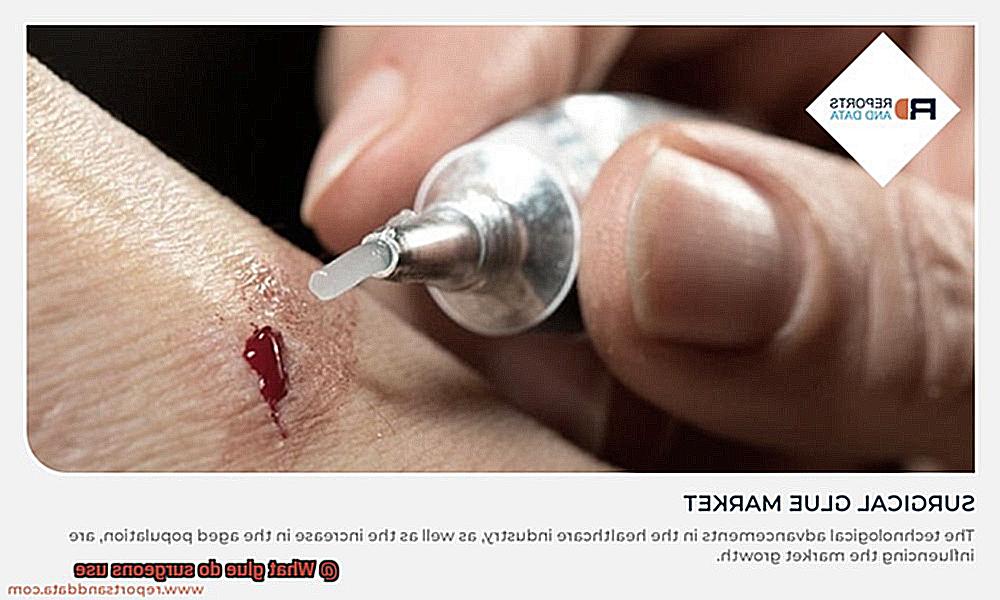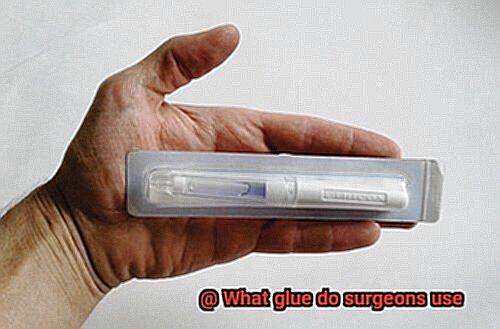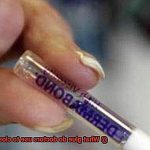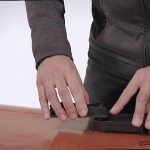Surgery is like a high-stakes game of precision, where success hinges on flawless wound closure. Surgeons have an arsenal of mind-boggling techniques and tools at their disposal, but one superhero stands out among them all – surgical adhesive. This magical glue, often referred to as “liquid stitches,” has revolutionized the way wounds are treated and healed in the world of medicine.
Gone are the days when traditional stitches left behind unsightly scars and required painstaking removal. In today’s medical landscape, surgical adhesives have swooped in as a versatile alternative, offering unparalleled accuracy, faster healing times, and better cosmetic results. But what exactly is this extraordinary glue that surgeons trust with life-saving closures and delicate repairs?
In this blog post, get ready to dive headfirst into the captivating realm of surgical adhesives. We’ll uncover the different types of glue used by surgeons today – from cyanoacrylates that bond like superheroes to fibrin sealants that work like magic potions. Together, we’ll unveil the unique qualities and applications of these adhesives, shedding light on how they’re pushing the boundaries of surgical innovation.
So buckle up for this enthralling journey as we unravel the secrets behind the glue that keeps surgeons stitch-free. By understanding its power and potential, we can ensure safer and more efficient surgeries for patients around the globe. Let’s get started.
What is Cyanoacrylate Glue?
Contents
- 1 What is Cyanoacrylate Glue?
- 2 How Does Cyanoacrylate Glue Work?
- 3 What is Fibrin Glue?
- 4 How Does Fibrin Glue Work?
- 5 Other Types of Adhesives Used by Surgeons
- 6 When Should Surgeons Use Surgical Glues?
- 7 Benefits of Using Surgical Glues Over Traditional Sutures
- 8 Risks Associated with Using Surgical Glues
- 9 Conclusion
Cyanoacrylate glue, also known as super glue, is an exceptional adhesive renowned for its strength, versatility, and rapid bonding capabilities. It has revolutionized various industries, including medicine, where it has transformed wound closure and surgical procedures. This article will delve into the world of cyanoacrylate glue, exploring its properties, uses, advantages, and disadvantages.
Properties and Uses:
Cyanoacrylate glue is derived from cyanoacrylate monomers that transform into a durable polymer when exposed to moisture. This adhesive acts swiftly, forming a strong bond within seconds. Its versatility knows no bounds as it can bond plastics, metals, rubber, ceramics, wood, and even human tissue.
In the medical field, cyanoacrylate glue has become a game-changer. Surgeons use medical-grade versions of this adhesive as an alternative to traditional sutures or stitches. It excels in situations where wounds are small or in hard-to-reach areas. By providing a strong bond that holds tissues together without external materials like sutures or staples, cyanoacrylate glue simplifies wound closure procedures.
Advantages:
One of the major advantages of cyanoacrylate glue is its antimicrobial properties. It forms a protective barrier over wounds, preventing bacteria from entering and reducing the risk of infection. This quality is invaluable in surgical procedures where maintaining sterility and preventing complications are paramount.
Additionally, cyanoacrylate glue promotes faster healing by creating a flexible film over the wound. This film shields the wound from external factors while allowing it to breathe and heal naturally. The rapid bonding properties of this adhesive also reduce the risk of reopening the wound and minimize scarring.
Disadvantages:
Despite its many advantages, cyanoacrylate glue has limitations. It may not be suitable for all types of wounds or procedures. Surgeons carefully assess each case to determine the most appropriate method of wound closure, considering factors such as size, location, and patient-specific factors.
Furthermore, cyanoacrylate glue should be used with caution on certain materials, such as cotton or wool, as it can cause heat and even ignite these substances. It is essential to follow the manufacturer’s instructions and take proper safety precautions when working with this adhesive.
How Does Cyanoacrylate Glue Work?
Allow me to introduce you to the superhero of adhesives – cyanoacrylate glue, also known as super glue. This fast-acting adhesive has revolutionized the medical field, empowering surgeons with precision and efficiency. In this article, we will embark on an enthralling journey into the world of cyanoacrylate glue, unraveling the secrets behind its extraordinary performance.

The Polymerization Process:
The secret behind cyanoacrylate glue’s remarkable bonding properties lies in a process called polymerization. When this glue encounters moisture, whether from the air or the surface being bonded, it undergoes rapid polymerization. During this reaction, long chains of molecules are formed, creating an incredibly strong bond. The catalyst for this reaction is the presence of cyano groups in the glue’s composition.
Unyielding Bond:
Cyanoacrylate glue boasts exceptional bonding strength, enabling it to adhere to a variety of surfaces, including skin and tissues, with unwavering tenacity. This unparalleled adhesion makes it an invaluable tool during surgical procedures where stability and support are paramount.
Waterproof Seal:
In addition to its formidable bond, cyanoacrylate glue creates a waterproof seal. Once it hardens, it forms an impenetrable barrier that prevents any fluids or substances from permeating the bonded area. This feature proves particularly advantageous in surgical applications where a watertight seal is essential.
Antimicrobial Properties:
Cyanoacrylate glue possesses antimicrobial properties as well. When it undergoes polymerization, small amounts of formaldehyde are released. These trace amounts help deter bacterial growth on the bonded surface, reducing the risk of infection during surgical procedures.
Considerations for Use:
While cyanoacrylate glue offers numerous advantages, caution is crucial when utilizing it in surgical settings. Internal tissues should be evaluated carefully before using this glue, as it may cause irritation or tissue damage. Additionally, it is essential to remember that cyanoacrylate glue is not a substitute for traditional sutures or other wound closure methods. Instead, it can serve as an adjunct or temporary solution.
What is Fibrin Glue?
In the world of adhesives, there is one superhero that stands out from the rest – fibrin glue. Derived from human plasma, this incredible adhesive has become a game-changer in the medical field, providing surgeons with a powerful tool to seal wounds and promote healing. In this article, we will explore the fascinating properties and applications of fibrin glue.
The Power of Biocompatibility:
Fibrin glue possesses a superpower that sets it apart from other adhesives – biocompatibility. Derived from human plasma, it poses minimal risk of adverse reactions or complications compared to synthetic adhesives. This makes it incredibly valuable, especially for patients who may be more prone to allergies or infections.
Adhesion Like No Other:
Fibrin glue possesses exceptional adhesive properties, allowing it to bond with various tissues with ease. From skin and muscle to internal organs, this versatile adhesive can be used in a wide range of surgical procedures across different medical specialties. Its ability to create a strong bond between tissues ensures effective wound closure and reduces the risk of further bleeding.
The Healing Touch:
But fibrin glue doesn’t stop at adhesion; it has additional biological properties that aid in the healing process. Acting as a scaffold, it provides a platform for cells to migrate into the wound site. It also promotes the formation of new blood vessels, which are vital for tissue oxygenation and nutrition. This biological support accelerates the healing process and enhances patient recovery.
Application and Limitations:
Applying fibrin glue is simple – surgeons mix the fibrinogen and thrombin components just before use and apply the mixture directly to the target area using specialized tools. However, fibrin glue’s biological nature limits its shelf life, requiring careful storage and timely use. Additionally, its cost may pose challenges in certain cases, though the potential benefits often outweigh the expense.
How Does Fibrin Glue Work?
Imagine a superhero adhesive that can stop bleeding, promote wound healing, provide support to tissues, prevent infection, and even disappear over time. Look no further than fibrin glue. In this blog post, we’ll dive into the fascinating world of fibrin glue and explore how it works its magic in the operating room.
The Dynamic Duo: Fibrinogen and Thrombin
Fibrin glue is made up of two components – fibrinogen and thrombin. Fibrinogen, a protein found in blood plasma, joins forces with thrombin, an enzyme responsible for blood clotting. Together, they create a powerful adhesive that performs miracles in surgery.
The Formation of a Fibrin Clot
When applied to a surgical site, fibrin glue rapidly forms a gel-like substance through the reaction between fibrinogen and thrombin. This reaction converts fibrinogen into fibrin, which creates a mesh-like structure at the application site. This fibrin clot acts as a scaffold for the migration of cells involved in wound healing.
Stopping Bleeding and Promoting Healing
Fibrin glue acts as a sealant by adhering to the tissue surface and creating a barrier, effectively stopping bleeding. This not only prevents further bleeding but also provides support to the surrounding tissues, reducing complications and accelerating healing.
Tissue Adhesion and Mechanical Support
Beyond stopping bleeding, fibrin glue has adhesive properties that help hold tissues together. When applied to a wound, it forms strong bonds with the tissue surface and other layers of the glue itself. This adhesion provides mechanical support, reducing tension on the wound edges and facilitating better healing.
The Shield Against Infection
Fibrin glue boasts antimicrobial properties that help prevent infection. The fibrin clot formed by the glue acts as a physical barrier, preventing bacteria and microorganisms from entering the wound site. This is especially beneficial in high-risk surgical procedures.
Biodegradation: The Final Act
A remarkable feature of fibrin glue is its biodegradability. As the wound heals, the body’s natural processes gradually remove the glue, eliminating the need for manual removal. This biodegradation allows for better tissue integration and avoids potential complications associated with non-biodegradable adhesives.
Other Types of Adhesives Used by Surgeons
When it comes to surgery, scalpels and stitches often come to mind. However, surgeons also rely on a lesser-known but equally important tool in their arsenal – adhesive. These adhesive materials play a crucial role in sealing wounds and promoting healing. In this article, we will delve into the fascinating world of surgical adhesives, exploring their diverse types and applications in various surgical procedures.
Cyanoacrylate: The Superhero of Surgical Adhesives
Surgeons employ cyanoacrylate, commonly known as super glue, for delicate procedures that require precision and quick bonding. This adhesive marvelously seals small blood vessels and repairs tiny tears in organs. Picture super glue going to work inside your body – it’s akin to a superhero coming to the rescue.
Fibrin Glue: Nature’s Clotting Companion
Derived from human blood, fibrin glue contains components that aid in clotting. This adhesive is perfect for tissue grafts or reattaching severed nerves and blood vessels. Fibrin glue acts as a natural scab, assisting your body in healing itself.
Hydrogels: Water-Based Wonders
Hydrogels function like sponges, effectively absorbing and retaining fluid. Surgeons utilize them in delicate eye surgeries to seal incisions and protect tissues. Moreover, these remarkable materials can even deliver medication precisely where it’s needed, like superheroes with a secret power.
Polyethylene Glycol (PEG): The Trusty Bonding Buddy
PEG-based adhesives excel at joining tissues together, making them ideal for hernia repairs or nerve surgeries that require reconnecting damaged fibers. PEG acts as a reliable friend who ensures everything stays firmly in place.
Biological Glues: Harnessing Nature’s Sticky Magic
Surgeons may employ glues made from collagen or gelatin derived from animals. These biological glues work wonders in attaching soft tissues or sealing wounds. It’s like using nature’s own glue to mend our bodies.
When Should Surgeons Use Surgical Glues?
When it comes to closing wounds, surgeons have a multitude of options, but surgical glues are gaining popularity as an alternative solution. So when should surgeons use surgical glues? Let’s explore the factors that influence this decision.
- Type and location of the wound: Surgical glues are ideal for superficial wounds or incisions not under tension, such as those on the skin or internal organs. Traditional closure methods may prove challenging in these cases.
- Difficulty of application: Delicate tissues or areas with limited access can make sutures or staples difficult to apply. Surgical glues offer a valuable tool for wound closure in these situations.
- Risk of infection: Wounds with a higher risk of infection can benefit from surgical glues. The adhesive properties create a protective barrier against bacteria, reducing the likelihood of infection.
- Scarring potential: Surgical glues minimize scarring by providing a seamless closure compared to sutures or staples that create puncture wounds. This results in less visible scarring for patients.
- Patient suitability: Not all patients are suitable for glue closure. Allergies to glue components, compromised immune systems, or conditions impairing wound healing may require alternative closure methods.
- Adhesive properties: Surgeons consider the adhesive properties of different surgical glues. Some glues offer better flexibility and elasticity, making them more suitable for areas experiencing movement and stretching.
Benefits of Using Surgical Glues Over Traditional Sutures
When it comes to wound closure, surgical glues are the unsung heroes that offer a multitude of benefits over traditional sutures. In this article, we will explore the advantages of using surgical glues, from faster healing times to reduced scarring and enhanced patient comfort. Say goodbye to stitches and hello to a new era of wound closure.
Faster Healing Time:
Surgical glues have a clear advantage in promoting faster healing. With their ability to instantly bond tissues together, they eliminate the need for time-consuming stitching and knotting. This means less time spent in the operating room and a quicker recovery for patients.
Reduced Infection Risk:
Worried about infection? Surgical glues have got you covered. Unlike sutures that create small puncture wounds as potential entry points for bacteria, surgical glues form a protective barrier over the wound. This not only minimizes the risk of infection but also keeps those pesky pathogens at bay.
Improved Cosmetic Outcome:
Nobody wants an unsightly scar, especially in visible areas like the face or neck. Surgical glues offer an improved cosmetic outcome compared to sutures. By creating a seamless bond between the wound edges, they result in a smoother, less noticeable scar. Say goodbye to those telltale stitch marks and hello to a more aesthetically pleasing result.
Enhanced Patient Comfort:
Let’s face it – nobody likes the discomfort and itching that comes with having foreign objects in their skin. Surgical glues provide enhanced patient comfort by eliminating the need for sutures. No more itching or pain caused by stitches – just smooth healing without any protruding objects.
Reduced Scarring:
In addition to improving cosmetic outcomes, surgical glues can also help reduce scarring. By keeping the wound edges close together and minimizing tension, they contribute to better long-term aesthetic results. Say goodbye to raised and prominent scars that sutures sometimes leave behind.
Versatility:
Surgical glues are like the Swiss Army knives of wound closure. They are incredibly versatile and can be used on a wide range of tissues, including skin, blood vessels, and even internal organs. This makes them suitable for various surgical procedures, whether it’s an open surgery or a minimally invasive technique. Surgeons have the freedom to choose the most appropriate adhesive for each specific case.
Risks Associated with Using Surgical Glues
Today, we’re going to embark on an eye-opening journey into the hidden risks that accompany the use of surgical glues. While these glues offer a multitude of benefits over traditional wound closure methods, it’s crucial to be well-informed about their potential downsides. So, let’s peel back the layers and delve into the sticky truth.
Allergic Reactions:
Just as some individuals have allergies to certain foods or medications, they can also develop an allergic reaction to the components of surgical glue. Picture this: redness and swelling engulfing the wound site, an unbearable itchiness that torments the senses, and in severe cases, blistering or skin necrosis. To minimize this risk, surgeons conduct thorough assessments of a patient’s medical history and perform patch tests before applying surgical glue.
Invasion of Infection:
While surgical glues create a protective barrier against bacteria, there is still a chance for these pesky invaders to infiltrate if the glue is improperly applied or wound preparation is insufficient. Imagine a battalion of bacteria stealthily making their way beneath the adhesive layer, initiating an infection within the very wound intended for healing. To counteract this risk, meticulous wound cleaning and preparation are essential.
Toxic Tensions:
Some surgical glues contain chemicals that can inflict damage upon tissues or impede the healing process itself. Surgeons must carefully select the appropriate glue for each procedure, considering factors such as wound location and patient health. Picture a delicate balance between choosing a glue that effectively seals the wound but does not endanger tissue integrity or hinder healing.
Strength Struggles:
Surgical glues have their limitations when it comes to strength and flexibility compared to sutures or staples. Imagine a wound with significant tension or located in a highly mobile area like joints. In such cases, the adhesive properties of surgical glues may not provide sufficient stability for proper closure. Alternatives methods, such as sutures or staples, would prove more suitable for ensuring a secure and stable wound closure.
Now that we’ve thoroughly examined the potential risks associated with using surgical glues, it is crucial to remember that when used correctly by trained professionals, these glues are generally considered safe.
As patients, it is essential to engage in open discussions with our surgeons regarding the potential risks and benefits of using surgical glues. After all, knowledge is the key to making informed decisions about our own healthcare.
VlOVnfN3vSE” >
Conclusion
In conclusion, surgeons rely on a variety of glues to assist them in their delicate procedures.
These specialized adhesives play a crucial role in sealing wounds, securing tissues, and promoting healing. From cyanoacrylate-based glues that bond quickly and securely, to fibrin sealants derived from human blood plasma that aid in clotting, surgeons have an array of options at their disposal.
Regardless of the specific glue used, surgeons are meticulous in selecting the right adhesive for each situation, ensuring optimal outcomes for their patients.






